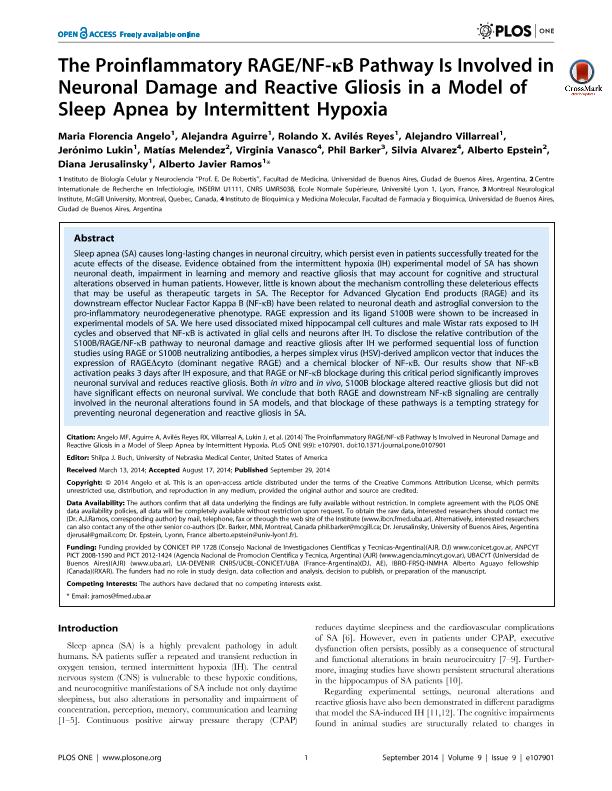Artículo
The proinflammatory RAGE/NF-κB pathway is involved in neuronal damage and reactive gliosis in a model of sleep apnea by intermittent hypoxia
Angelo, María Florencia ; Aguirre, Alejandra Inés
; Aguirre, Alejandra Inés ; Aviles Reyes, Rolando Xavier
; Aviles Reyes, Rolando Xavier ; Villarreal, Alejandro
; Villarreal, Alejandro ; Lukin, Jeronimo
; Lukin, Jeronimo ; Melendez, Matías; Vanasco, Virginia
; Melendez, Matías; Vanasco, Virginia ; Barker, Philip A.; Alvarez, Silvia
; Barker, Philip A.; Alvarez, Silvia ; Epstein, Alberto Luis; Jerusalinsky, Diana Alicia
; Epstein, Alberto Luis; Jerusalinsky, Diana Alicia ; Ramos, Alberto Javier
; Ramos, Alberto Javier
 ; Aguirre, Alejandra Inés
; Aguirre, Alejandra Inés ; Aviles Reyes, Rolando Xavier
; Aviles Reyes, Rolando Xavier ; Villarreal, Alejandro
; Villarreal, Alejandro ; Lukin, Jeronimo
; Lukin, Jeronimo ; Melendez, Matías; Vanasco, Virginia
; Melendez, Matías; Vanasco, Virginia ; Barker, Philip A.; Alvarez, Silvia
; Barker, Philip A.; Alvarez, Silvia ; Epstein, Alberto Luis; Jerusalinsky, Diana Alicia
; Epstein, Alberto Luis; Jerusalinsky, Diana Alicia ; Ramos, Alberto Javier
; Ramos, Alberto Javier
Fecha de publicación:
09/2014
Editorial:
Public Library of Science
Revista:
Plos One
ISSN:
1932-6203
Idioma:
Inglés
Tipo de recurso:
Artículo publicado
Clasificación temática:
Resumen
Sleep apnea (SA) causes long-lasting changes in neuronal circuitry, which persist even in patients successfully treated for the acute effects of the disease. Evidence obtained from the intermittent hypoxia (IH) experimental model of SA has shown neuronal death, impairment in learning and memory and reactive gliosis that may account for cognitive and structural alterations observed in human patients. However, little is known about the mechanism controlling these deleterious effects that may be useful as therapeutic targets in SA. The Receptor for Advanced Glycation End products (RAGE) and its downstream effector Nuclear Factor Kappa B (NF-κB) have been related to neuronal death and astroglial conversion to the pro-inflammatory neurodegenerative phenotype. RAGE expression and its ligand S100B were shown to be increased in experimental models of SA. We here used dissociated mixed hippocampal cell cultures and male Wistar rats exposed to IH cycles and observed that NF-κB is activated in glial cells and neurons after IH. To disclose the relative contribution of the S100B/RAGE/NF-κB pathway to neuronal damage and reactive gliosis after IH we performed sequential loss of function studies using RAGE or S100B neutralizing antibodies, a herpes simplex virus (HSV)-derived amplicon vector that induces the expression of RAGEΔcyto (dominant negative RAGE) and a chemical blocker of NF-κB. Our results show that NF-κB activation peaks 3 days after IH exposure, and that RAGE or NF-κB blockage during this critical period significantly improves neuronal survival and reduces reactive gliosis. Both in vitro and in vivo, S100B blockage altered reactive gliosis but did not have significant effects on neuronal survival. We conclude that both RAGE and downstream NF-κB signaling are centrally involved in the neuronal alterations found in SA models, and that blockage of these pathways is a tempting strategy for preventing neuronal degeneration and reactive gliosis in SA.
Palabras clave:
Neuronal Damage
,
Rage/Nf-Κb Pathway
,
Reactive Gliosis
Archivos asociados
Licencia
Identificadores
Colecciones
Articulos(IBCN)
Articulos de INST.DE BIOLO.CEL.Y NEURCS."PROF.E.DE ROBERTIS"
Articulos de INST.DE BIOLO.CEL.Y NEURCS."PROF.E.DE ROBERTIS"
Articulos(IBIMOL)
Articulos de INSTITUTO DE BIOQUIMICA Y MEDICINA MOLECULAR
Articulos de INSTITUTO DE BIOQUIMICA Y MEDICINA MOLECULAR
Citación
Angelo, María Florencia; Aguirre, Alejandra Inés; Aviles Reyes, Rolando Xavier; Villarreal, Alejandro; Lukin, Jeronimo; et al.; The proinflammatory RAGE/NF-κB pathway is involved in neuronal damage and reactive gliosis in a model of sleep apnea by intermittent hypoxia; Public Library of Science; Plos One; 9; 9; 9-2014; e107901
Compartir
Altmétricas



